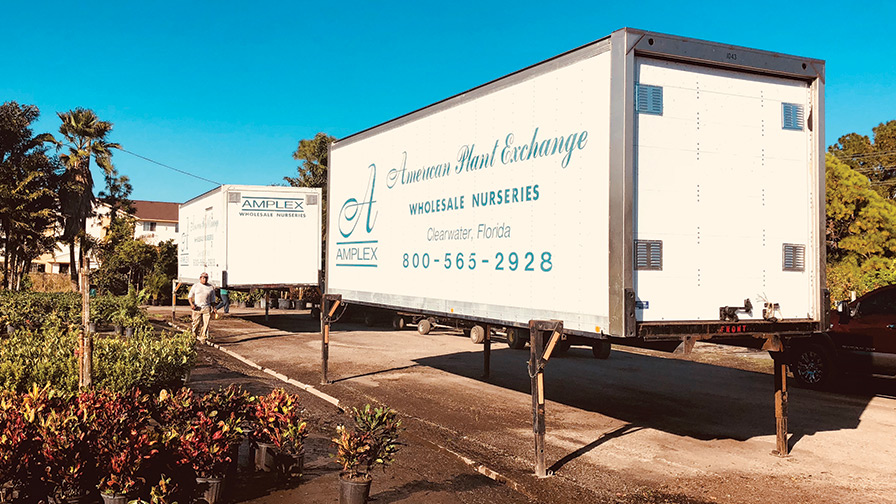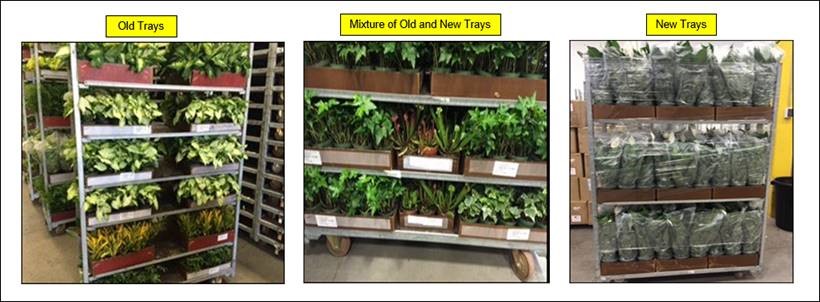New Shipping Innovations Helping Greenhouse Growers Navigate Transportation Challenges

AMPLEX from Demountable Concepts
Greenhouse growers are not alone in searching for innovative solutions to the trucking and shipping challenges facing them. Companies such as Demountable Concepts, Inc. and Container Centralen are a great example of this.
The editors of Greenhouse Grower recently asked Gerry Hazzard, National Account Executive at Demountable Concepts, and A.J. Lambert, Director, Sales and Account Management at Container Centralen, about how they are helping growers deal with increasingly stringent regulations.
Greenhouse Grower (GG): How are you working with your customers, especially those involved in delivering plants, to help them deal with changing shipping regulations?
Gerry Hazzard: We offer two Demountable Systems to companies operating greenhouses and nurseries. Each utilizes specially equipped truck bodies that stand on retractable legs and can be loaded independent of the truck’s power unit. For horticultural oriented companies, we offer standard van bodies, flatbeds, and stake bodies, and refrigerated bodies. Trucks can be equipped with lift gates or walk-ramps.
The Swap-Body system eliminates downtime associated with loading trucks. Stand-alone bodies are loaded throughout the day at the greenhouse, while other bodies are on the truck(s) making deliveries. This allows trucks to deliver more goods per shift than standard straight trucks and frees-up more time to be spent arranging loads without slowing down deliveries. Most growers use a combination of van and flatbed bodies.
Warehouse on Wheels lets horticultural companies deliver more efficiently in remote markets. Fewer straight trucks and drivers are required and the need for cross-docking at the remote market is eliminated.
Multiple demountable bodies (usually two) are loaded and line-hauled over a long distance on a semi-trailer where they are transferred to demountable-equipped straight trucks which make deliveries. Since the straight truck drivers are local to the regional market, drivers have more time per shift to dedicate to making deliveries. Driver hours of service are reduced because the tractor-trailer with a single driver is hauling two bodies instead of to two straight truck drivers, one driving each truck. Plus, delivery drivers are stationed locally and don’t have to drive the stem to the remote market.
A.J. Lambert: We expected the new regulations to have a significant impact on how our growers service their customers. Ahead of the regulations taking effect, Container Centralen (CC) expanded the services offered by our subsidiary company, CCDS (Container Centralen Delivery Services). This division of CC allows us to assist growers with all facets of transportation. By allowing CCDS to handle the delivery of racks to the grower’s farm for use, it then allows growers to better use their own transportation more efficiently for shipping product to stores and not to pickup racks from a warehouse to ship on. Additionally, we have expanded our Crossdock services. Beginning in 2015, CC offered Crossdock services in the Midwest, helping to eliminate waste within growers supply chains. In 2018, CC expanded this to offering to 12 locations. Because this allows growers to ship dock to dock versus multi stop retail deliveries for their linehaul runs, it makes finding a carrier to haul the product much easier and at a much more reasonable rate. CC then handles the crossdock and final mile delivery of the product to the stores.
GG: What types of technology are you developing to make trucking/shipping live plants more efficient, or to help maximize truck space?
Hazzard: The Demountable Swap Body System reduces the hours of service because drivers simply hop into preloaded trucks and begin their shift, and at the end of the day they swap an empty body for a loaded body to be ready for an immediate start the next morning. Throughout the day, alternate bodies are loaded independent of the truck to keep everything moving. Drivers don’t spend any of their hours of service loading trucks, or waiting for trucks to be loaded.
For remote markets, Amplex, located in Clearwater, FL, utilizes the Warehouse on Wheels System to control fleet size and driver hours of service, and keep trucks moving.
Locally stationed drivers in the Miami area, operating straight trucks, pick up plants from smaller nurseries, and once full, two bodies are transferred onto a semi-trailer and shuttled to Clearwater twice a day (about 288 miles one-way). The system cuts drive time to and from Clearwater in half because the tractor-trailer with a single driver is hauling two bodies instead of to two straight truck drivers, one driving each truck.
Lambert: At CC, we use a TMS system as well as load boards to ensure that we are getting the best price for our customers when we handle their freight. Regarding racks and truck space, many of our customers have implemented FlowVision’s RIO software, which helps to efficiently place product on CC racks to maximize cube. CC has also implemented a consolidation program in the Central Florida market. This program is basically a pickup and delivery operation in which CC delivers empty racks to local growers and then picks them back up loaded with plants. We then bring all product on racks back to our warehouse to get ready for shipping. CC has worked with tray suppliers to develop a tray that helps maximize rack cube, thereby helping increase the number of plants being shipped from the Central Florida market, while at the same time reduce handling and labor as well as reduce the transportation costs since carriers can now go dock to dock versus 8 to 10 stops where they are floor loading product.

Container Centralen Consolidation Services
GG: How might the electronic logging device mandate impact the industry?
Hazzard: ELDs will cause an increased emphasis on hours of service for drivers and create increased enforcement focus on staying within those hours. The Demountable System helps manage hours of service regulations because it reduces hours spent in non-driving activities during the shift for each driver because bodies can be loaded independent of the truck.
In the swap body system, drivers start their day when they get into a preloaded truck and pull away from the facility to make deliveries. Except for the 10 minutes it takes to swap an empty body for a loaded body, drivers spend their service-hours driving and making deliveries.
With the Warehouse on Wheels system, multiple bodies are shuttled to the regional market on a semi-trailer eliminating long stem drives for straight trucks. It also eliminates the number of drivers required because two bodies are hauled on the semi-trailer.
Lambert: The initial impact from ELDs came in the form of rising rates. Driver productivity decreases, which leads to an increase in loads available and therefore, basic economics tell you that rates will go up. Because drivers are now on the clock officially, we will continue to see less patience for sluggish shippers. This means that we will see more and more accessorial charges such as detention with power, as well as more and more carriers dropping loads when shippers are not prepared when the trucks arrive. Customers have indicated that they have had to adjust their shipping because of ELDs. We have noticed in certain markets that customers that run their own transportation have begun to shrink their geographic reach due to ELD implementation. Because CC uses box trucks within our warehouse operations, we have not been impacted by ELDs for the recovery of CC racks at retail stores.









